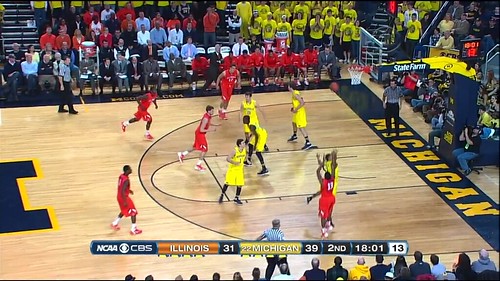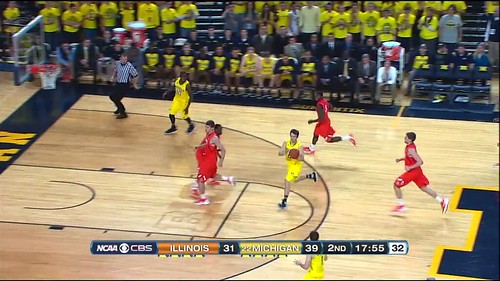Hoops Picture Pages: Running the Break

In his recap of the Illinois game, Brian left a bit of a hint about what I should take a look at when watching film this week:
Michigan got a ton of fast break and secondary transition points; in the second half when Illinois was crashing the boards hard anything that didn't end up getting rebounded by the trees fell to a shorter faster Michigan player and the resulting transition opportunity was often an odd-man break. I'd be interested to see a breakdown of Illinios points off of offensive rebounds versus points in transition when Michigan actually got the board. I'd guess it would be a small advantage to Illinois, but not one that outweighs the benefits of going small to Michigan's halfcourt offense.
You know Brian; he puts the 'b' in subtle. Somehow managing to pick up on this, I took a look through the film at each of Illinois's missed shots, recording the result of the miss (offensive or defensive rebound), points scored off those misses, and how often a Wolverine rebound resulted in a fast or secondary break. Brian's assessment was pretty darn accurate.
Illinois second-chance points: 9
Michigan transition points directly following a defensive rebound: 9
The Illini, like Brian stated, went all-out on the offensive glass, coming up with 14 offensive boards (although two of those were "team rebounds" when Michigan knocked the ball out of bounds). I counted 18 defensive rebounds for the Wolverines—the box score shows one more; I think that came in the waning seconds—and had this breakdown of what they did with them:
Fast break: 4 opportunities, 4 points.
Secondary break: 5 opportunities, 5 points.
Michigan slowed pace and went into their half-court offense on the other nine rebounds; as you can see, half the time they were running after a miss. Here's a closer look at how Michigan pushed the pace off a miss. In this first frame, you see Illinois putting up an outside shot while the Wolverine have four players in good position to get a rebound:
Illinois ends up with three players either inside or directly next to the paint as Evan Smotrycz grabs the board. Before Smotrycz even hits the ground, everyone but Burke is charging up the court. Burke starts to flash to the middle of the floor in case Smotrycz needs an outlet:
Smotrycz turns and takes one dribble. This snapshot is taken right before he passes to Novak, whose feet you can see at the very top of the screen. Hardaway is already well down the floor, and Michigan has the numbers to run:
Novak gets the pass on the wing and heads to the middle of the floor, drawing in the Illini defense. Douglass trails and is wide open as Illinois is late to figure out matchups and making sure that Hardaway—who's behind the defense—is accounted for:
Douglass gets a wide-open look for three, though his shot draws iron. Still, Michigan is able to create a great look from distance by recognizing Illinois's aggressiveness on the offensive glass and countering. Full video of the play:
Douglass actually ended up with a second open look on the secondary break later in the half. On this particular play Michigan is really able to go full-bore as it's Burke who comes down with the rebound, enabling the other four players to head up the floor without worrying about who's going to handle the ball in the backcourt. Burke drives hard into the paint, catching Illinois off-guard and freeing up Douglass for a shot from the exact same spot as earlier. Unfortunately, he misses again, but it's still a nice play by Burke to create the shot:
In case you're feeling the need to complain about Stu—unwarranted, in my opinion, as he hit two of his other three shots while playing phenomenal defense on Brandon Paul (7 TOs)—here he is taking it coast-to-coast for a layup when he sees an opening in the Illini D:
While Michigan once again was dominated on the glass in their own end, they largely negated this advantage for Illinois by making them pay for crashing the boards. With Ohio State—a team that thoroughly destroyed the Wolverines in the rebounding category in their first matchup—next up on the schedule, Michigan will need to continue exploiting these openings created when the Buckeyes get too aggressive offensively.
February 15th, 2012 at 5:56 PM ^
I appreciate the basketball write-ups.
One concern I have about Ohio is that they may control the offensive glass simply with their big men - that is, absent an exploitable team-wide aggression to crash the boards. Still - the mere fact that we have a CHANCE to beat Ohio and a CHANCE to finish with the best record in the Big Ten is enough to have me giddy.
February 15th, 2012 at 6:16 PM ^
Nice write-up and good overall analysis.
I have a few views on the Illinios game also. With no statistical analysis of this, only from what I've seen with my own eyes in live time, what I remember about the Illinois game is there being a few times they were able to get 2, 3, even 4 chances off their misses; they didn't score and we would eventually get the ball and fast break/transition game our way to scores. We simply cannot let this happen against Ohio St. imo, because they WILL score with a 2nd and 3rd/(4th!) opportunity.
I'd love to see Michigan somehow take advantage of something like this but there will be a difference between Ohio St. and Illinois on the boards; and how Ohio St. eventually finishes the possession will differ from Illinois' (i.e they came up empty multiple times). Sullinger and the atheltes they have crash the boards very well. They showed Michigan that the last game they played and this scares me again going into Satruday night. Something needs to change this time around but I personally don't know if a small lineup is the answer. Just one man's opinion. Go Blue.
February 16th, 2012 at 1:05 AM ^
decided to do some extremely minimal statistical analysis to test one aspect of your comment. although i'd be interested to consider the effects of giving up third/fourth chances, all "second chance points" are a second chance on a previous miss, regardless of what happened earlier in the sequence. with that in mind, a simple ratio of second chance points per offensive rebound should be a loose metric for how badly one opponent (Illinois) versus another (OSU) punished us on the offensive glass. i'll call it the obvious: "points per second-chance opportunity" and abbreviate Pp2c.
thanks to the handy box scores over at mgoblue, i have a single resource for making this comparison. (spoiler: i'm also throwing in both MSU games and it's ugly)
obligatory chart?
mandatory chart:
| Opponent | 2nd Chance Pts | Offensive Reb | Ratio (2cP/OR) |
|---|---|---|---|
| vs Illinois | 9 | 14 | .64 Pp2c |
| @OSU | 16 | 14 | 1.14 Pp2c |
| @MSU | 16 | 12 | 1.33 Pp2c |
| vs MSU | 13 | 9 | 1.44 Pp2c |
chart meet eyeballs. eyeballs, chart. b-nut's hypothesis/fear that we (obviously) shouldn't allow OSU to grab as many offensive rebounds as we did against Illinois is spelled out in a minute sample size. same number of rebounds, 7 more points (+.5pts per offensive rebound!)
furthermore, eyeball loves chart regarding MSU being a monster around the offensive rim. they will make you pay and showed it in both of our matchups. although the OR totals are low, this may be a factor of efficiency in actual second chance opportunities (fewer "third/fourth chance" situations).
what i'd like to do is compare this to the other side of the coin from brian's "subtle hint" in the game writeup. unfortunately i have no access to numbers for what ace calls "transition points directly following a defensive rebound". the obvious counterpoint he set up is "points per transition rebound" (PpTR), which was 9/9 (1.00 PpTR) for Michigan according to Ace. in brian's model, aggressive offensive rebounding opponents are a challenge, but it can be mitigated if PpTR is also high. makes it even easier when the opponent manages a mere .64 points every time they earn a second look.
anyway this was my first attempt to add some analytical value to the blog. not much to offer but conceptually its relevant to the current squad and our rebound struggles. cheers to all for getting me thinking about hoops strategy.
February 16th, 2012 at 11:35 AM ^
This is great stuff. Watching the tape, it was pretty clear that Illinois didn't do a great job of converting their second-chance opportunities. Some of that was missing layups, but a lot of it came when Leonard would bat the ball out top and Illinois would just jack up a deep shot; I don't think we'll be seeing much of that from Ohio State.
I've bookmarked this comment in case I want to come back to this point after the OSU game. If so, I'll be looking at the same numbers, and I'll definitely re-post your chart (with full credit, of course). Thanks for sharing this.
February 16th, 2012 at 2:33 PM ^
Thanks for taking the time to put this together. I guess at this point we wait and see what happens Saturday night. This matter may just be one theme of the night, maybe it'll be the theme I fear it could be that dominates us, or maybe we clear the boards and it's no issue. Regardless, discussion and comments like this that make this fun place to come to.
February 16th, 2012 at 11:54 AM ^
Thanks for the analysis, I appreciate the bball coverage. Go Blue!
February 16th, 2012 at 12:36 PM ^
Even without the analysis, it seems clear as day that we can't afford that many OR in a game vs a quality opponent. We got lucky vs Illinois - lucky we have JB and not Bruce Weber.




Comments